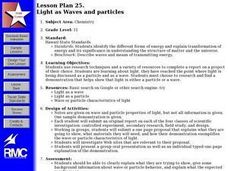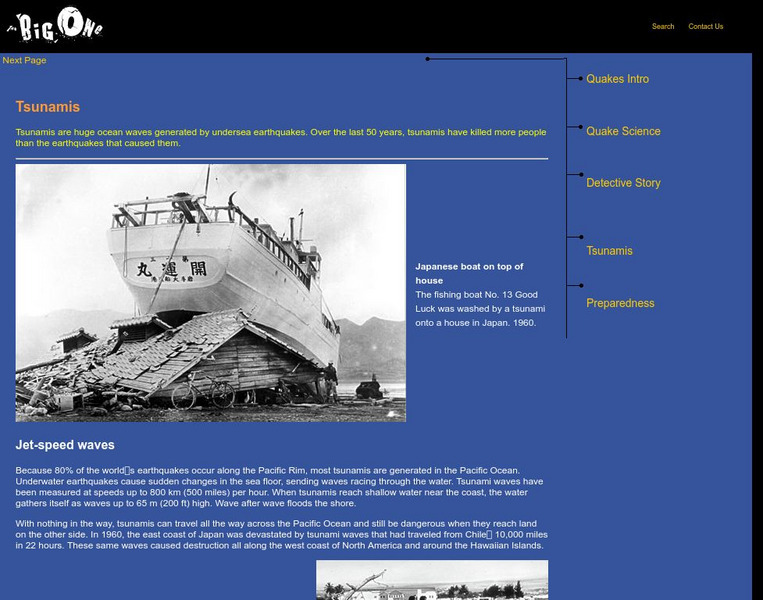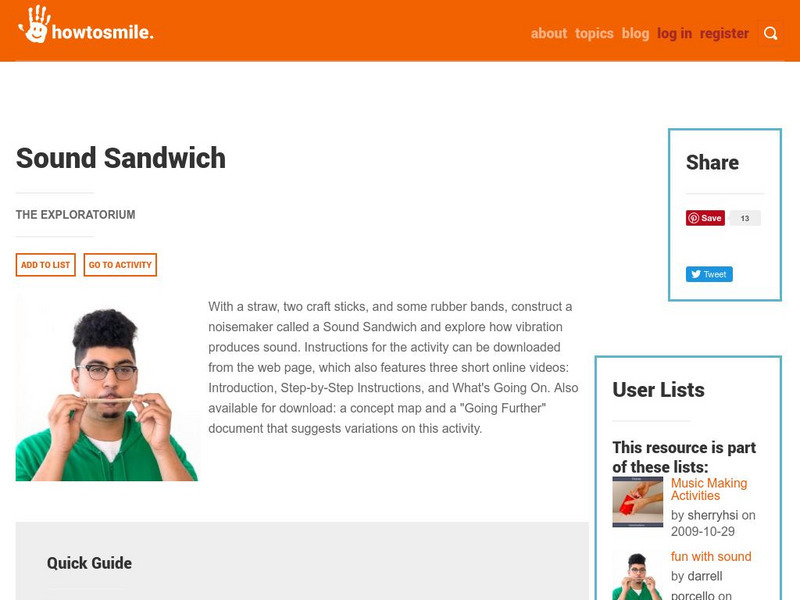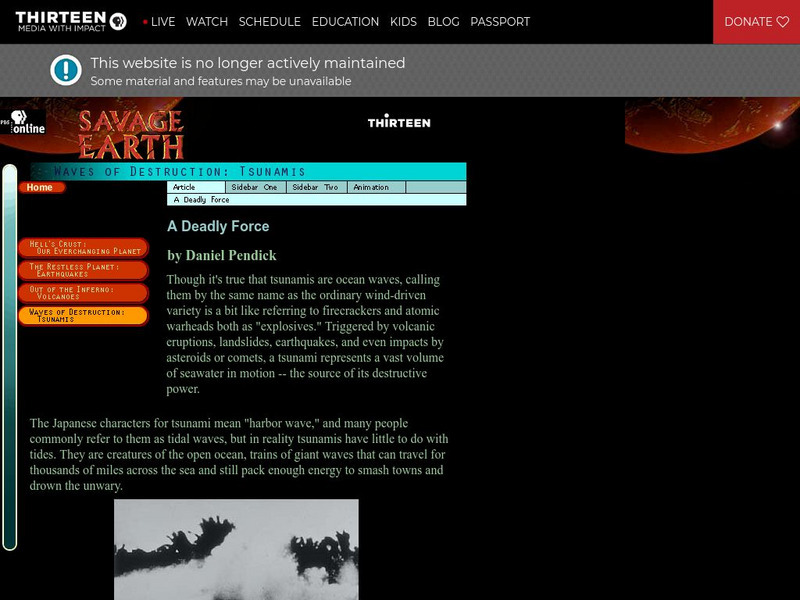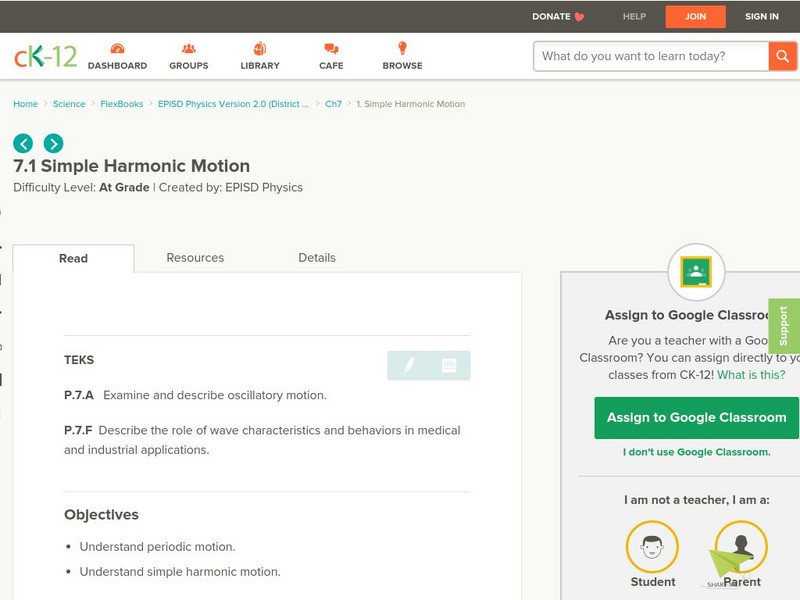Curated OER
Vibrations and Waves
In this vibrations and waves activity, students determine the period and frequency of a pendulum with the mass of .100 kg released. Then they determine whether the amounts increase, decrease, or stay the same when the same pendulum is...
Curated OER
"Why Is the Sky Blue?"
Students investigate why the sky is blue and the sunset is red. They are asked why do you think that we see the sky as blue? Students write a hypothesis on their "Blue Sky Lab Sheet". They explain why they think that the sky is blue...
Curated OER
Wave Equations
Students manipulate a model of a wave in order to solve the wave equation in 1 dimension. By using a model of a wave on a string the student is able to change the tension, length, and mass of the string as well as fix either end of the...
Curated OER
Light as Waves and Particles
Eleventh graders explore the wave and particle properties of light.
Georgia State University
Georgia State University: Hyper Physics: Scattering Concepts
A collection of several pages explaining the principles which underlie Rayleigh scattering of light.
Burke Museum
Burke Museum: Tsunamis
The information on tsunamis provided at this site is part of the Burke Museum's online exhibition on earthquakes and geology. Prevention is discussed, along with famous tsunamis in history.
University of Colorado
University of Colorado: Physics 2000: More About Visualizing Electromagnetic Waves
Discusses the nature of an electromagnetic wave. Explains the oscillating electric field and represents it through clever graphics and animations.
University of Colorado
University of Colorado: Physics 2000: Cat Scans: Projecting Shadows
This page and the three pages which follow discuss how X-ray technology can be used to produce an image of the human body. Discussion is understandable and highly intriguing. Several interactive animations allow the visitor to explore...
University of Colorado
University of Colorado: Physics 2000: Speed of Light
Using an interesting and intriguing format, this page discusses the question of "How does one measure the speed of light." Explanation focuses on Galileo's and Roemer's efforts to obtain a reasonable value. Also discusses Heinrich...
Science Education Resource Center at Carleton College
Serc: Investigation of Pitch and Rate of Vibration
An inquiry lesson where students explore pitch and the rate of vibration. Students will look at how the rate of vibration which creates pitch is affected by the size of the object studied.
University of Colorado
University of Colorado: Ph Et Interactive Simulations: Wave on a String
An interactive simulation that teaches about waves, frequency, and amplitude by observing the waves and vibrations of a string while changing variables like distance, speed, fixed or unfixed ends, and more. This simulation can either be...
PBS
Pbs: People & Discoveries Niels Bohr
A wonderful PBS biography of a great man. This contains many personal touches, yet does a fine job of describing Bohr's scientific work. But it's best at Bohr the man. Nice quotes, one in the middle, one at the end.
University of Colorado
University of Colorado: Ph Et Interactive Simulations: Wave on a String
Students can observe the properties of a wave with different variables. Students can experiment with the type of end, damping factor, and tension in the string. Possible teacher lesson plans are included at the bottom of the page.
Georgia Department of Education
Ga Virtual Learning: Sound
Through multiple animations and interactive activities, this module allows students to investigate the properties of sound.
Other
How to smile.org: Sound Sandwich
Students discover how vibrations produce sound by making this sound sandwich out of everyday materials. Lesson plans include three videos that give an introduction, step-by-step demonstration, and an explanation of the science behind the...
TeachEngineering
Teach Engineering: Waves and Wave Properties
Students learn about the types of waves and how they change direction, as well as basic wave properties such as wavelength, frequency, amplitude and speed. During the presentation of lecture information on wave characteristics and...
TeachEngineering
Teach Engineering: Learning Light's Properties
Students learn the basic properties of light--the concepts of light absorption, transmission, reflection and refraction, as well as the behavior of light during interference. Lecture information briefly addresses the electromagnetic...
Nobel Media AB
The Nobel Prize: The Nobel Prize in Physics 1929
This site from The Nobel Foundation tells the scientific work which earned Louis de Broglie the Nobel Prize in Physics. Here, you can read the Presentation Speech in which Professor C.W. Oseen praises Louis de Broglie's work and de...
TeachEngineering
Teach Engineering: Waves Go Public!
Students apply everything they have learned over the course of the associated lessons about waves, light properties, the electromagnetic spectrum, and the structure of the eye, by designing devices that can aid color blind people in...
TeachEngineering
Teach Engineering: The Three Color Mystery
Students are introduced to an engineering challenge in which they are given a job assignment to separate three types of apples. However, they are unable to see the color differences between the apples, and as a result, they must think as...
University of Colorado
University of Colorado: Physics 2000: Electromagnetic Waves
Using a student-teacher dialogue format, this page discusses the nature of light as an electromagnetic wave and the electromagnetic spectrum.
PBS
Wnet: Thirteen: Savage Earth: Tsunamis
Excellent site exploring the mysterious and destructive tsunamis. Explore this scientific marvel and learn about the causes and dangers.
PBS
Pbs Learning Media: What Is a Wave?
This interactive activity adapted from the University of Utah's ASPIRE Lab provides an overview of the characteristics and properties of various types of waves, including light waves, sound waves, and water waves.
CK-12 Foundation
Ck 12: Harmonic Motion
[Free Registration/Login may be required to access all resource tools.] Students explore periodic motion and simple harmonic motion by watching video clips, manipulating interactives, and solving practice problems.





